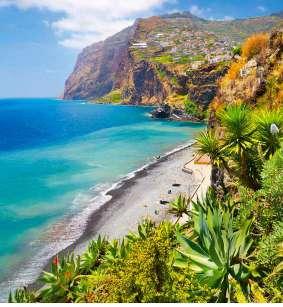
3 minute read
A gardener’s holiday in
How to spend a gardener’s holiday in… Madeira
Closer to Casablanca than Lisbon, the Portuguese island of Madeira sits in the Atlantic, far away from mainland Europe – and more than lives up to its epithet as the Garden Isle
A four-island archipelago with an eponymous main island, Madeira is in flower all year, supported by a mild climate and volcanic soil. Add spectacular scenery and a network of walkable irrigation canals, and it’s a big oering for a small island.
Flower island
The first people known to live on Madeira were 15th-century Portuguese settlers, who found forested clis over the ocean, waterfalls and interior highlands. In time, the long-life island wine became invaluable for traders who broke their long journeys on the island, while plant hunters passing through from the south and the east to northern Europe introduced such Madeiran landscape stalwarts as protea, camellia and agapanthus. Native plants include the geraniums G. palmatum and G. maderense, and there are at least 150 endemic floral species, supported by a diversity of fauna. Quinta do Palheiro, the lauded botanic garden of a former quinta (working estate) overlooks the capital city Funchal; other charming settings in town include Quinta Jardins do Lago and Quinta Vigia.

Insider tips

Best pastel de nata (custard tarts) in a garden Botanical Gardens, Funchal Best brunch Museu Café & Petisco, Funchal Best fishing port lunch Vila do Peixe, Câmara de Lobos Best sundowner Barreirinha Bar Café, Funchal Best vantage point Cabo Girão

Quinta do Palheiro.
Walk on by
All nature is a garden in Madeira: walking, scrambling, climbing or riding on a horse through the landscape is the best way to see how things grow. Known as the Floating Garden of the Atlantic, Flower Island or, more usually, the Garden Isle, Madeira is criss-crossed with walkable water conduits (levadas) dating from the earliest settlements, built to aid the production of sugarcane. The element of spectacle increases with the steepness of the terrain, arguably, and it is best to book walks with a guide. The levadas are protected landscapes; two thirds of the island form a nature reserve, while the whole of the north side is a designated UNESCO World Heritage site. The Laurisilva of Madeira is a relic of a previously widespread prehistoric laurel forest (subtropical forest dominated by trees from the endemic Lauraceae family) that covers 20 per cent of the island.
Laurisilva hiking routes.
Port of call
Driving in Madeira is not for the faint-hearted but there is a good network of buses, with drivers who are experienced at careering around hairpin bends. Nearby villages that are easily accessed by public transport include the fishing port Câmara de Lobos, nestled around a horseshoe-shaped bay and a typically rocky beach. Madeira, the drink, is represented here by the HQ of traditional manufacturers Henriques & Henriques, and further out, at Barbeito, Madeira’s state-ofthe-art winery. With temperatures ranging between a pleasant 17-25ºC throughout the year, Madeira is a good place to swim, from diving platforms – the next island, Porto Santo, is all sandy beaches but involves a five-hour round trip by ferry. Flora and fauna are protected from Atlantic winds by the high clis around the island edges, interior highlands and forests; Cabo Girão, slightly west, is Europe’s secondhighest promontory.
Cabo Girão.
A predominance of fennel
Early settlers were familiar with wild fennel, if not the island’s other endemic species, and there was a lot of it around the bay. The first sea captain to arrive called it Plantation of Fennel, translating as Funchal. Today, the capital city is the most cosmopolitan part of the archipelago, with art galleries, snack bars – highly recommended for no-frills, local food – and streets cobbled with classic black-and-white Portuguese paving. Sound footwear is advised, in town and country. By the sea front, food and drink vans provide another good alternative to formal dining, as does Macaronésia Garden Terrace Café, on the roof of the old farmers’ market, Mercado dos Lavradores. Here you will find lavish displays of year-round local flowers, fish, fresh produce and every kind of passion fruit.
Mercado dos Lavradores, Funchal.
COMPILED BY KENDRA WILSON. PHOTOGRAPHS: BILDAGENTUR-ONLINE/JOKO ; JANA TELENSKA; JAN WLODARCZYK; PETR POHUDKA / ALL ALAMY STOCK PHOTO










